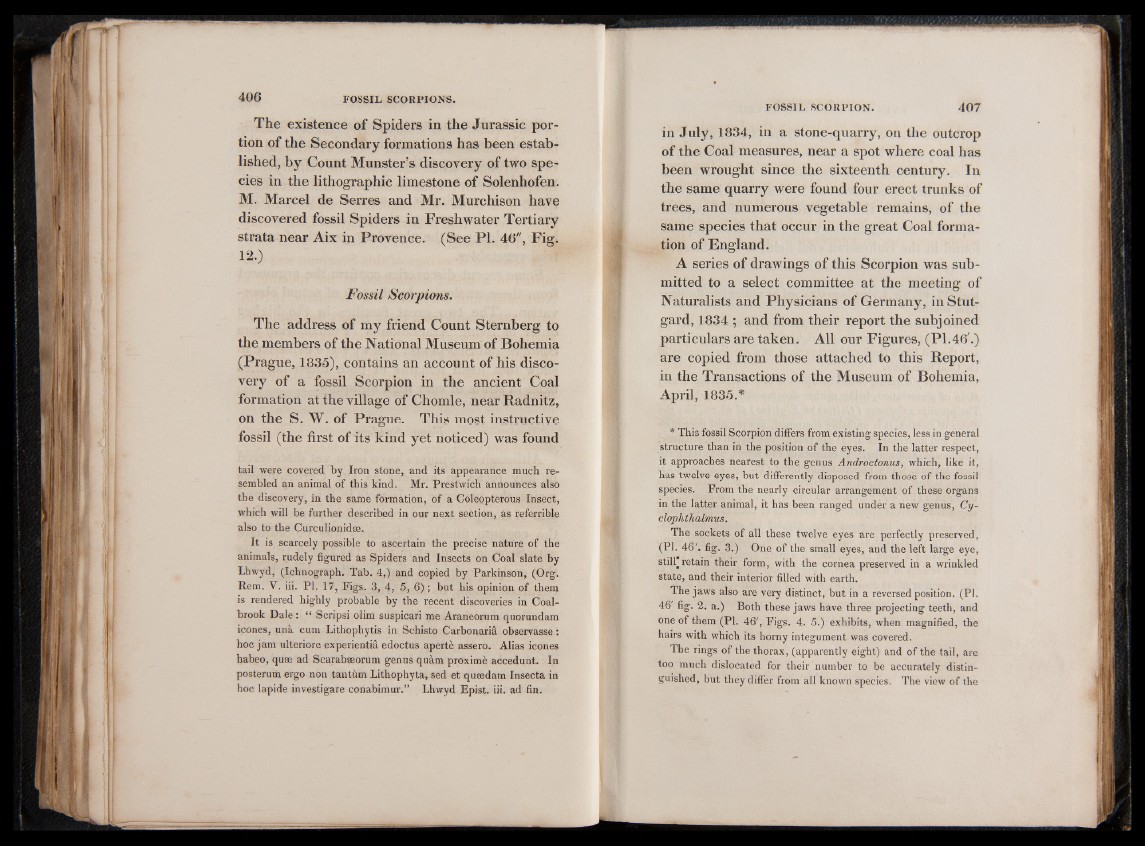
The existence of Spiders in the Jurassic portion
of the Secondary formations has been established,
by Count Munster’s discovery of two species
in the lithographic limestone of Solenhofen.
M. Marcel de Serres and Mr. Murchison have
discovered fossil Spiders in Freshwater Tertiary
strata near Aix in Provence. (See PI. 46", Fig.
12.)
Fossil Scorpions.
The address of my friend Count Sternberg to
the members of the National Museum of Bohemia
(Prague, 1835), contains an account of his discovery
of a fossil Scorpion in the ancient Coal
formation at the village of Chomle, near Radnitz,
on the S. W. of Prague. This most instructive
fossil (the first of its kind yet noticed) was found
tail were covered by Iron stone, and its appearance much resembled
an animal of this kind. Mr. Prestwich announces also
the discovery, in the same formation, of a Coleopterous Insect,
which will be further described in our next section, as referrible
also to the Curculionidae.
It is scarcely possible to ascertain the precise nature of the
animals, rudely figured as Spiders and Insects on Coal slate by
Lhwyd, (Ichnograph. Tab. 4,) and copied by Parkinson, (Org.
Rem. V. iii. PI. 17, Figs. 3, 4, 5, 6 ); but his opinion of them
is rendered highly probable by the recent discoveries in Coal-
brook D a le : “ Scripsi olim suspicari me Araneorum quorundam
icones, una cum Lithophytis in Schisto Carbonarifi. observasse:
hoc jam ulteriore experientia edoctus apert& assero. Alias icones
habeo, quae ad Scarabseorum genus qiram proximo accedunt. In
posterum ergo non tantiim Lithophyta, sed et qusedam Insecta in
hoc lapide investigare conabimur.” Lhwyd Epist. iii. ad fin.
FOSSIL SCORPION. 407
in July, 1834, in a stone-quarry, on the outcrop
of the Coal measures, near a spot where coal has
been wrought since the sixteenth century. In
the same quarry were found four erect trunks of
trees, and numerous vegetable remains, of the
same species that occur in the great Coal formation
of England.
A series of drawings of this Scorpion was submitted
to a select committee at the meeting of
Naturalists and Physicians of Germany, inStut-
gard, 1834 ; and from their report the subjoined
particulars are taken. All our Figures, (PI.46 .)
are copied from those attached to this Report,
in the Transactions of the Museum of Bohemia,
April, 1835.*
* This fossil Scorpion differs from existing species, less in general
structure than in the position of the eyes. In the latter respect,
it approaches nearest to the genus Androctonus, which, like it,
has twelve eyes, but differently disposed from those of the fossil
species. From the nearly circular arrangement of these organs
in the latter animal, it has been ranged under a new genus, Cy-
clophthalmus.
The sockets of all these twelve eyes are perfectly preserved,
(PI. 46'. fig. 3.) One of the small eyes, and the left large eye,
still_ retain their form, with the cornea preserved in a wrinkled
state, and their interior filled with earth.
The jaws also are very distinct, but in a reversed position. (PI.
46 fig. 2. a.) Both these jaws have three projecting teeth, and
one of them (PI. 46', Figs. 4. 5.) exhibits, when magnified, the
hairs with which its horny integument was covered.
The rings of the thorax, (apparently eight) and of the tail, are
too much dislocated for their number to be accurately distinguished,
but they differ from all known species. The view of the